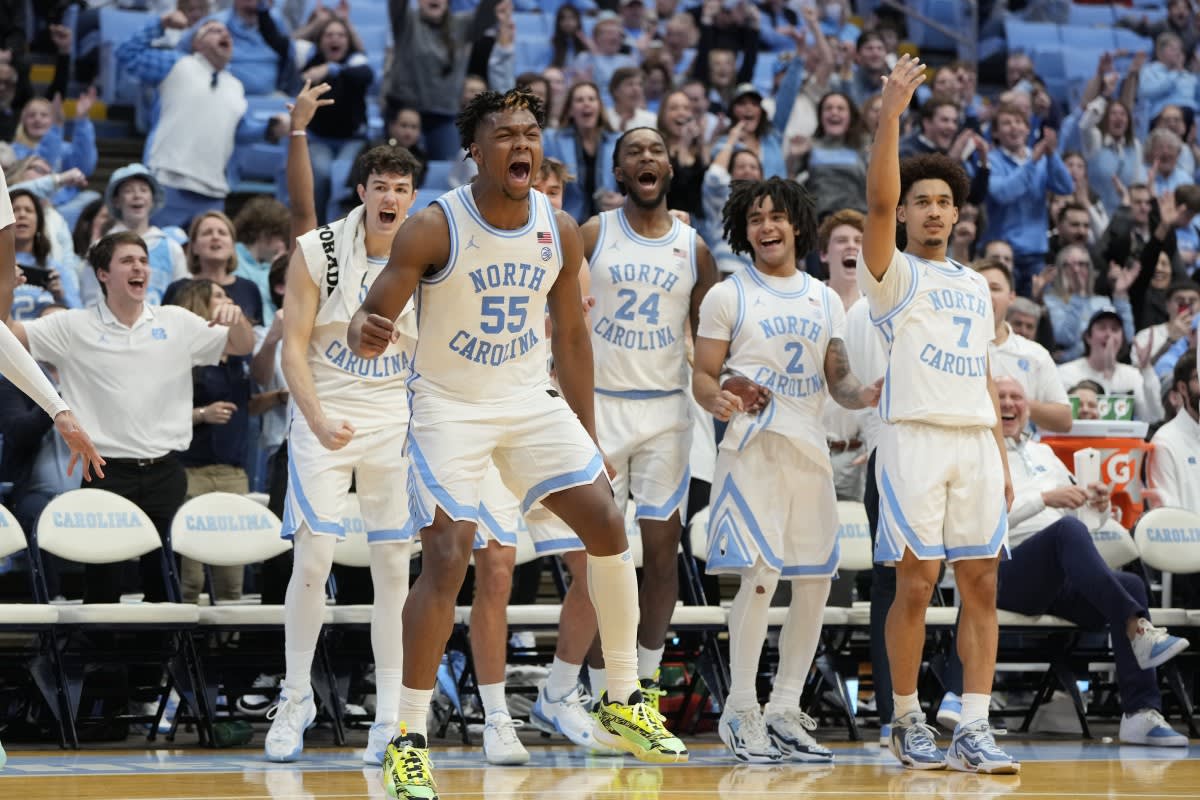What a difference a year makes for the North Carolina Tar Heels men’s basketball team.
A year ago, North Carolina was in the midst of one of the most disappointing seasons in modern college basketball history. The Tar Heels underwent an unthinkable fall from grace in coach Hubert Davis’s second season, crippling under the weight of the expectations from a preseason No. 1 national ranking to miss the NCAA tournament. Vibes, mojo, whichever word you prefer, the Heels were missing it. They spent a year trying to rediscover the magic of March 2022, when UNC ripped through the Big Dance and came oh so close to an eighth national championship.
That 2022-23 flop put all sorts of pressure on Davis entering his third year on the job. To put him on the hot seat 18 months after playing for the national championship would have been going too far, but ’23-24 certainly felt like a tenure-defining campaign for the man tasked with leading the Tar Heels in the post-Roy Williams era. And while success in Chapel Hill is defined mostly by triumphs in the third and fourth months of the year, Davis’s reshaping of this UNC roster has passed its early tests with flying colors. Saturday’s dominant win over Syracuse was just the latest example.

Bob Donnan/USA TODAY Sports
Carolina swapped out three starters from the 2022-23 team, most notably Caleb Love, who transferred to Arizona in what has generally been considered a mutual parting of ways. Love took more blame than he perhaps deserved for UNC’s struggles a year ago, but it didn’t take a PhD in basketball to observe the shaky fit between him and backcourt mate RJ Davis, especially with a lack of three-point shooters around them. Davis kept in place the nucleus of RJ Davis and recent 2,000-point scorer Armando Bacot and surrounded them with more shooting, more unselfish players and more experience. Neither transfers Cormac Ryan and Harrison Ingram nor elite freshman Elliot Cadeau are lighting the world on fire offensively, but they’ve completely changed how North Carolina plays on both ends.
“We’ve all got one goal, and that’s just to win,” Bacot said postgame. “I think in the past, we’ve had different goals and different aspirations, but this team, our main goal is just to win.”
Offensively, Cadeau’s presence frees RJ Davis up to hunt shots, while Ingram and Ryan provide perimeter gravity with their ability to space the floor. The result: the senior may well be the nation’s best backcourt player. He lit up Syracuse for 22 points on 12 shots Saturday, his 10th 20+ point game of the season. All the while, he’s shooting a career-best 40% from three and turning the ball over at the lowest rate of his career. Ingram, meanwhile, has enjoyed a bounceback year after a disappointing two seasons at Stanford, fitting in far better as a connective piece with positional versatility than the featured offensive option he was in Palo Alto. The ball sticks less than it did a year ago, the Heels have shot around five percentage points better from three than they did in 2022-23 and the bench has provided more of a spark than it did a year ago, when UNC ranked 360th out of 363 Division I teams in bench minutes. Offensive clinics like the 103 points put up Saturday afternoon in Chapel Hill won’t happen every night, but there’s an impressive flow to how the Heels are operating offensively right now.
“In the summer and the preseason, we did a great job with role definition,” Ingram said. “Everybody kind of knows what shots [Hubert Davis] wants us to take and not to take … I feel like we’re playing really well for each other right now.”
But North Carolina’s most notable leap from last year (and really most of Davis’s tenure) has been on the defensive end, where the Tar Heels have blossomed into one of the nation’s best units. Saturday was the first time an opponent had topped 60 points against the Tar Heels since before Christmas, a stretch that included three ACC road wins in grind-it-out fashion. The growth feels less about personnel and more about effort: From the opening tip Saturday, North Carolina brought a level of intensity on the defensive end that was rare early in Davis’s tenure but has been commonplace this year. That has perhaps been aided by a major stylistic shift made early this season, doing less off-ball switching to instead focus on matching up with your man.
“We would do a lot of switching, so [if] a guy scores, ‘Okay, he scored on me, he scored on him, it doesn’t matter,’” Ingram said. “Now, it’s like, if this guy has 30 points, it’s on me … we’re taking more pride guarding our man.”
The result: What Bacot called the best defense the Tar Heels have had in his five-year tenure with the program. UNC’s defensive numbers may be at least temporarily inflated by abnormally-low shooting splits from their opponents (In its last four ACC games, opponents are shooting just 12–86 from beyond the arc), but there are far more teeth to this defensive unit than there was a year ago. And with that has come a resurgent Tar Heel bunch that at present looks like the ACC’s best team and a legitimate factor come March. North Carolina climbed to No. 5 in KenPom’s national rankings after Saturday’s dismantling, and the Heels have their sights set on running through the ACC’s regular season.
“[We’re] starving,” Bacot said. “We want to keep winning… we want to go undefeated [in the ACC].”







